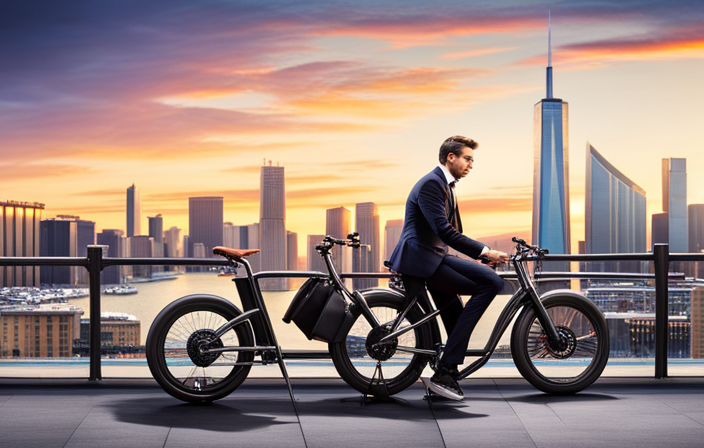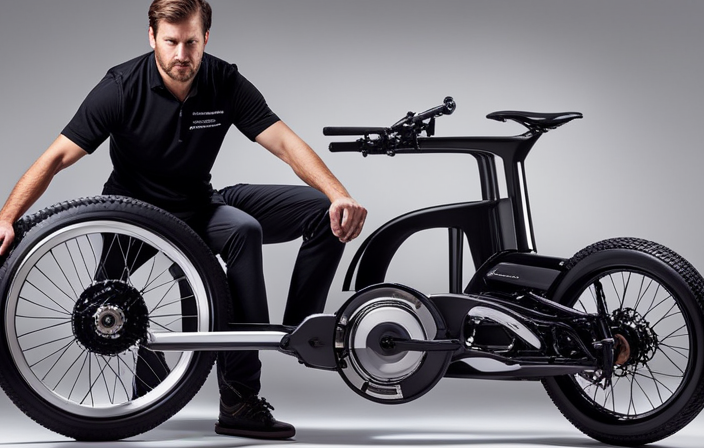Locking up an electric bike is like fortifying a fortress. It’s a vital task that requires precision and strategy.
As an electric bike enthusiast, I understand the importance of keeping our prized possessions safe and secure.
In this article, I will guide you through the intricate process of locking up your electric bike, sharing expert tips and techniques to ensure maximum protection.
So, let’s dive into the world of bike security and learn how to safeguard our beloved rides.
Key Takeaways
- Choose a secure parking spot and use a strong bike lock
- Register your electric bike with local authorities for increased chances of recovery
- Use a bike cover to protect your bike from prying eyes and the elements
- Stay vigilant and report any suspicious activity to authorities
Assess the Security Risks in Your Area
Assessing the security risks in your area is crucial for protecting your electric bike. Imagine a bustling city street with crowded bike racks and lurking thieves eyeing your bike. It is important to evaluate the effectiveness of bike sharing programs in reducing traffic congestion and assess the economic impact of electric bikes.
Understanding the potential threats and vulnerabilities in your surroundings is crucial. Consider factors such as the crime rate in your area, the presence of surveillance cameras, and the overall level of security. Additionally, take into account the popularity of electric bikes and the demand they may attract from thieves.
With this information, you can make an informed decision on the level of security measures needed to safeguard your electric bike. To ensure maximum protection, invest in a high-quality lock that is resistant to cutting and tampering.
Invest in a High-Quality Lock
Investing in a top-notch security device will provide added peace of mind when ensuring the safety of your valuable e-bike.
When it comes to choosing the right lock, there are a few important factors to consider. Firstly, make sure the lock is made of high-quality materials such as hardened steel, as this will make it more resistant to cutting or picking.
Secondly, opt for a lock that is certified by a reputable testing organization, such as Sold Secure or ART. These certifications ensure that the lock has undergone rigorous testing to meet certain security standards.
Additionally, it is crucial to regularly maintain your lock by lubricating the keyhole and checking for any signs of wear or damage.
Lastly, using a u-lock or d-lock will provide maximum security, as they are extremely difficult to break or manipulate.
Transitioning into the next section, using the right lock is just the first step in keeping your electric bike safe and secure.
Use a U-Lock or D-Lock for Maximum Security
For ultimate protection, opt for a sturdy U-lock or D-lock, which will act as an impenetrable fortress for your prized e-bike. These bike lock options provide maximum security due to their robust construction and design. U-locks and D-locks are made of hardened steel, making them resistant to cutting, prying, and picking. Their compact size also makes them difficult to maneuver around, discouraging thieves.
To further enhance security, consider using alternative measures such as cable locks or chains in combination with the U-lock or D-lock. This creates multiple layers of defense, making it even more challenging for thieves to steal your electric bike. Additionally, investing in a lock with a high-security rating can provide added peace of mind.
Locking both the frame and the wheels is crucial to ensure comprehensive protection for your e-bike. By securing all components, you minimize the risk of theft and increase the overall security of your electric bike. Transitioning into the subsequent section, let’s explore the importance of properly locking both the frame and the wheels to deter potential thieves.
Lock both the Frame and the Wheels
Ensure comprehensive protection for your beloved e-bike by securing both the frame and the wheels like a fortress, creating a formidable barrier that will deter even the most determined thieves.
When it comes to locking your electric bike, it’s crucial to understand the importance of securing not just the frame, but also the wheels. By using a high-quality U-lock or D-lock, you can effectively immobilize the wheels, preventing them from being easily removed or tampered with. This adds an extra layer of security, as thieves often target wheels as they are easier to steal.
When assessing bike lock effectiveness, keep in mind that locking both the frame and the wheels significantly reduces the risk of theft. However, it’s also worth considering alternative bike locking methods, such as cable locks or chain locks, to further enhance your bike’s security.
By employing these measures, you can ensure that your e-bike remains safe and secure.
Transitioning into the subsequent section about ‘secure your bike to a fixed object,’ it’s essential to choose the right type of lock to effectively protect your bike.
Secure your Bike to a Fixed Object
Attach your beloved e-bike securely to a sturdy fixed object, fortifying its protection against potential thieves. To achieve maximum security, consider these bike lock alternatives and follow these tips for bike storage:
- Use a heavy-duty U-lock or chain lock to secure your bike to a fixed object, such as a bike rack or a sturdy pole.
- Avoid using cable locks as they can be easily cut by thieves.
- Opt for a lock that is resistant to picking and cutting techniques.
- Consider using a secondary lock, such as a cable lock, to secure your bike’s wheels to the frame.
By employing these strategies, you can significantly reduce the risk of your e-bike being stolen.
Once your bike is securely locked, it is crucial to choose a well-lit and visible location to park, ensuring that your bike remains visible and less appealing to thieves.
Choose a Well-Lit and Visible Location to Park
Selecting a brightly lit and visible area to park your e-bike is like shining a spotlight on potential thieves, deterring them from attempting to steal it. When choosing a well-lit location, prioritize safety precautions and parking etiquette.
Look for areas with ample lighting that allow for easy visibility, making it harder for thieves to go unnoticed. Additionally, consider parking your e-bike near high foot traffic areas, as this provides an added level of security. By doing so, you increase the chances of someone noticing any suspicious activity.
Remember, thieves prefer easy targets, so making your bike more visible and less accessible decreases the likelihood of theft. However, it’s essential to note that selecting a well-lit location is just one layer of protection. To further enhance security, consider using additional measures such as GPS tracking. This ensures that even if your bike is stolen, you have a higher chance of recovering it.
Consider Using Additional Security Measures such as GPS Tracking
When it comes to keeping your electric bike secure, choosing a well-lit and visible location to park is essential. However, sometimes that may not be enough. To provide an extra layer of security, consider using additional measures such as GPS tracking.
GPS tracking can be a valuable tool in preventing theft and recovering your bike if it is stolen. Here are three benefits of using GPS tracking for your electric bike:
- Real-time location tracking: With GPS tracking, you can monitor the exact location of your bike at all times, giving you peace of mind.
- Theft prevention: The presence of a visible GPS tracker can deter potential thieves from targeting your bike.
- Recovery assistance: In the unfortunate event that your bike is stolen, GPS tracking can greatly increase the chances of recovering it.
However, it’s important to consider the pros and cons of GPS tracking, such as the cost of the device and potential privacy concerns.
To further protect your electric bike, the next step is to remove valuables and accessories from your bike.
Remove Valuables and Accessories from your Bike
To maximize the security of your valuable possessions, it is advisable to remove any accessories and valuable items from your bike. Bike theft prevention should always be a priority, and this step can significantly reduce the risk.
Bike accessories such as lights, bells, and baskets are attractive to thieves and can be easily removed if not properly secured. Additionally, valuable items like phones, wallets, and keys should never be left on your bike, as they can be quickly snatched. By removing these items, you eliminate the temptation for thieves and make your bike less appealing as a target.
Securing bike accessories separately, either by taking them with you or by locking them in a secure bag, adds an extra layer of protection. With your accessories and valuables safely removed, you can now focus on the next step: registering your bike with the local authorities.
Register your Bike with the Local Authorities
After removing valuables and accessories from your bike, the next step in securing your electric bike is to register it with the local authorities. This is an important step in protecting your investment and increasing the chances of recovering your bike if it is stolen.
Registering your bike involves providing information such as the make, model, and serial number to the local police or bike registration program. By doing so, you are creating a record of ownership that can be used to identify and return your bike in the event that it is found.
Additionally, assessing local crime rates can help you understand the level of risk in your area and take appropriate security measures. Once your bike is registered, it is recommended to take photos and keep a record of your bike’s serial number for further identification purposes.
Take Photos and Keep a Record of your Bike’s Serial Number
It’s crucial to capture images and document the serial number of your bike for easy identification purposes. Bike theft statistics show that a stolen bike is often difficult to recover, but having a record of your bike’s serial number significantly increases the chances of getting it back.
Here are four tips for preventing bike theft:
-
Take clear, detailed photos of your bike from various angles. This will aid in identification and provide evidence if needed.
-
Write down the serial number of your bike and keep it in a safe place. This unique identifier is essential for police reports and insurance claims.
-
Use a bike registration service offered by your local authorities or online platforms. This adds an extra layer of protection and facilitates the return of stolen bikes.
-
Consider engraving your contact information on the bike frame. It deters thieves and helps authorities identify the rightful owner.
By following these preventative measures, you can significantly reduce the risk of bike theft.
Now, let’s move on to the next section about using a bike cover to conceal and protect your bike.
Use a Bike Cover to Conceal and Protect your Bike
Using a bike cover has multiple benefits. It not only shields your bike from prying eyes and the elements but also adds an extra layer of security. Bike covers come in different types, such as waterproof, UV-resistant, and heavy-duty covers. Waterproof covers protect your bike from rain and snow, while UV-resistant covers prevent color fading and cracking due to sun exposure. Heavy-duty covers are designed to withstand harsh weather conditions. When choosing a bike cover, consider the size and dimensions of your electric bike to ensure a proper fit. It’s important to be mindful of public bike racks and parking regulations to ensure you are using your bike cover appropriately and complying with local rules and regulations.
Be Mindful of Public Bike Racks and Parking Regulations
Beware of the maze of rules and regulations surrounding public bike racks and parking, as it can be a wild ride trying to navigate the dos and don’ts.
When it comes to parking your electric bike in a public area, assessing parking availability and choosing the right bike lock are crucial. Before leaving your bike unattended, ensure that the public bike rack is secure and in compliance with local regulations. Look for racks that are sturdy and well-maintained, as they will provide a safer option for locking up your bike. Additionally, always opt for a high-quality bike lock that is resistant to cutting, picking, and prying. Investing in a strong U-lock or chain lock will greatly increase the security of your electric bike.
Now that you know how to properly secure your bike, let’s move on to the next step and discuss why it’s important to park your bike in a busy and active area.
Park your Bike in a Busy and Active Area
Choose a bustling and vibrant location to park your bicycle for added safety and peace of mind. When it comes to bike theft prevention, the importance of community awareness cannot be overstated. By parking your electric bike in a busy and active area, you increase the chances of deterring potential thieves.
These areas are typically well-lit and have a constant flow of people, making it difficult for someone to tamper with your bike unnoticed. Additionally, the presence of other bikes and pedestrians creates a sense of accountability, as people are more likely to notice any suspicious activity.
It is important to be mindful of your surroundings and choose a location that is easily accessible for you, while also being visible to others. By following this advice, you can significantly decrease the likelihood of your electric bike being stolen or tampered with.
In the next section, we will explore why it is crucial to avoid leaving your bike unattended for long periods of time.
Avoid Leaving your Bike Unattended for Long Periods of Time
Leaving your bike unattended for long periods of time is like leaving a juicy piece of fruit unguarded in a busy market – it’s just asking to be taken. To avoid becoming an easy target for thieves, it is essential to assess local crime rates and choose a secure parking spot. When assessing crime rates, consider the history of bike thefts in the area and the measures taken by local authorities to combat such crimes. Look for areas with good lighting, surveillance cameras, and bike racks that are well-anchored to the ground. Additionally, opt for locations with high foot traffic, as this can deter potential thieves. Remember, the goal is to make it as difficult as possible for someone to steal your bike. By taking these precautions, you significantly reduce the risk of your bike being targeted. Stay vigilant and report any suspicious activity to ensure the safety of your electric bike. Transitioning to the next section, it is important to stay aware of your surroundings and be proactive in protecting your bike.
Stay Vigilant and Report any Suspicious Activity
Always be on the lookout and report any unusual activity that you observe in order to ensure the safety of your ride. As electric bikes become more popular, they also become potential targets for theft. To stay alert and prevent any incidents, follow these guidelines:
- Pay attention to your surroundings: Stay vigilant and keep an eye out for anyone acting suspiciously around your bike.
- Note any unusual behavior: If you notice someone tampering with locks or trying to gain access to electric bike components, report it immediately.
- Document incidents: Take pictures or videos of any suspicious activity and provide detailed descriptions when reporting to the authorities.
By staying alert and promptly reporting any incidents, we can work together to deter theft and protect our electric bikes. Remember, your vigilance is crucial in maintaining the security of your ride.
Frequently Asked Questions
How can I assess the security risks in my area?
To assess security risks in my area, I gather neighborhood crime statistics and analyze them. By examining trends and patterns, I can identify potential risks and take necessary precautions to ensure the safety of my belongings and myself.
What type of lock should I invest in for my electric bike?
To effectively assess the lock effectiveness for my electric bike, I would recommend investing in a high-quality U-lock or chain lock. These locks offer superior strength and resistance to cutting, making them ideal for securing valuable assets like electric bikes.
Is it necessary to lock both the frame and the wheels?
Yes, it is necessary to lock both the frame and wheels of your electric bike for optimal security. By doing so, you minimize the risk of theft. Additionally, consider bike registration as an extra precautionary measure.
Are there any additional security measures I can take besides using a lock?
In addition to using a lock, I recommend considering additional security measures and alternative locking methods for your electric bike. These can include using a chain or cable lock, installing a GPS tracker, and parking in well-lit areas with high foot traffic.
Why is it important to register my bike with the local authorities?
Registering your bike with local authorities is crucial as it helps in preventing bike theft and aids in recovery if stolen. It increases the chances of finding your bike and deters potential thieves. Remember: "An ounce of prevention is worth a pound of cure."
Conclusion
In conclusion, securing your electric bike is crucial to deter theft and ensure its safety. By following the steps outlined in this article, you can greatly reduce the chances of your bike being stolen.
Firstly, it is important to assess security risks. This involves considering where you park your bike and whether there are any visible security measures in place. Choosing well-lit and busy areas can help deter thieves.
Secondly, investing in a high-quality lock is essential. Opt for a sturdy lock that is specifically designed for bikes. This will make it more difficult for thieves to break or cut through the lock.
Lastly, when locking your bike, make sure to secure both the frame and wheels. Thieves often target bikes with quick-release wheels, so using a secondary lock to secure the wheels can provide an extra layer of protection.
Remember, your bike is like a precious gem in a sea of rocks, so treat it with the utmost care and caution. Stay vigilant and protect your electric bike like a skilled castle guard protecting a priceless treasure.









